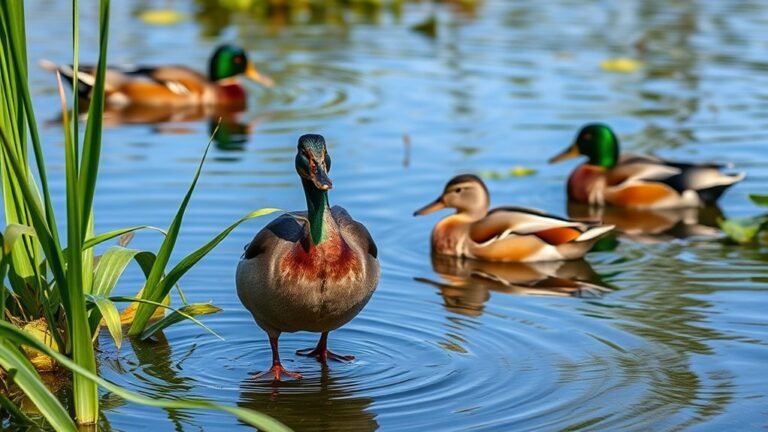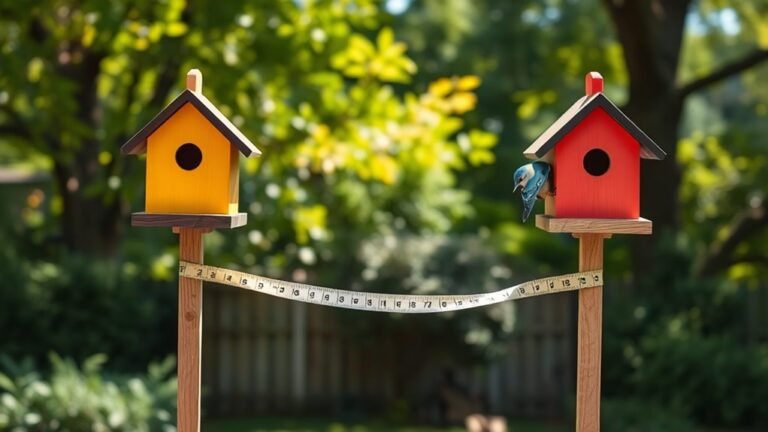What Do Cardinal Bird Nests Look Like? Nesting Habits Explored
Cardinal bird nests have a compact, bowl-like shape. They use various materials to build their nests. The outer layer is strong for protection, while the inside is soft to keep the young warm. Cardinals prefer dense vegetation for their nests. This choice raises questions about their nesting strategies. Factors that influence nest construction include material availability, safety from predators, and environmental conditions. Understanding these habits can provide insight into their survival and interactions with the environment.
Key Takeaways
Cardinal nests are small, bowl-shaped structures made from twigs, grass, and leaves. These materials provide security and insulation for the eggs and chicks. The inner lining of the nests is soft and often includes feathers and synthetic fibers for comfort. Cardinals like to build their nests in thick bushes or low tree branches to remain hidden.
They usually choose nesting sites near water sources. This offers easy access to food and shelter. Cardinals show impressive skills in building their nests, demonstrating their resourcefulness and creativity in construction.
Overview of Cardinal Species
Cardinals are vibrant birds that belong to the Cardinalidae family. This family includes several species, such as the Northern Cardinal and the Pyrrhuloxia. Each species has its own unique behaviors.
Cardinals often form strong pair bonds and engage in social interactions. You can see them singing and feeding together.
Their diet mainly consists of seeds, fruits, and insects, which shows their ability to adapt to different environments.
When feeding, cardinals exhibit characteristic flicking movements that highlight their agility and foraging techniques. These behaviors help them thrive in their ecosystems.
Many people enjoy watching cardinals due to their lively nature and resilience in the wild.
Physical Characteristics of Cardinal Nests
Cardinals build nests using twigs, grass, and leaves. This process shows their natural ability to use materials found in their environment.
The nests appear as small, compact bowls with a soft inner lining, providing comfort for their eggs and chicks. The design emphasizes security and insulation. The outer layer consists of stronger branches to protect against the weather and predators.
Cardinals typically place their nests in shrubs or low tree branches for concealment. Observing cardinal nests reveals their nesting behavior, highlighting the relationship between form and function in bird architecture.
This showcases nature's creativity.
Common Nesting Materials Used by Cardinals
Cardinals build their nests using several common materials, each selected for its benefits. These materials provide warmth, stability, and camouflage, playing a crucial role during the breeding season.
Here are the main materials cardinals use:
- Twigs and small branches: These create a strong outer layer for the nest.
- Grass and leaves: These provide insulation and make a soft inner lining.
- Mud or clay: This binds the nest, adding strength and stability.
- Feathers: These offer warmth for the developing chicks.
- Synthetic fibers: Sometimes, they use man-made materials for added comfort.
These materials not only support the nest's structure but also highlight the adaptability of cardinals in their environment.
Ideal Nesting Locations and Habitat Preferences
Cardinals look for specific nesting locations to improve their breeding success. They prefer areas with dense vegetation, such as shrubs or low trees, which offer shelter and hiding spots.
They tend to nest in spaces with clear boundaries, like woodland edges or yards with plenty of shrubbery. This helps them avoid predators and access food easily.
Cardinals also like to nest near water, which provides more insects to feed their young.
Nest Construction Process and Techniques
Nesting begins with careful construction that shows how resourceful and adaptable cardinals are. They use various techniques to create well-formed nests.
Cardinals typically gather the following materials:
- Twigs and small branches
- Grasses and leaves
- Animal fibers, such as feathers
- Mud for added strength
- Plant stems and vine tendrils
These materials are woven together to form a strong, cup-shaped nest. Female cardinals mainly build the nest and choose locations that offer protection from predators.
This attention to detail reflects their natural instincts, creating a safe space for their young. Watching this process can enhance your appreciation for these fascinating birds.
Cardinal Clutch Size and Egg Description
Female cardinals usually lay three to five eggs in a clutch, but they can sometimes have up to six. This strategy helps ensure better care for the young by limiting the number of eggs, which aids in resource management.
Cardinal eggs can be light blue or darker blue, often with speckles. These color variations may help the eggs blend in with their surroundings, offering protection from predators.
Observing these practices highlights the balance in nature, showcasing how cardinals raise their young in a challenging environment. You can appreciate the effort involved as they work to care for the next generation.
Incubation Period and Parental Roles
After laying their eggs, the female cardinal incubates them for about 11 to 13 days. She keeps the eggs warm to support their development. During this time, the male cardinal helps by feeding and protecting her.
Here are key points about this process:
- The female sits on the nest to maintain warmth.
- The male collects food for the female.
- They occasionally switch incubating duties so the female can take breaks.
- Both parents stay alert to keep predators away.
- Keeping a stable nest temperature is crucial for the embryos.
These behaviors show how both cardinals work together in parenting, contributing to the well-being of their young.
Fledging Process: When Young Cardinals Leave the Nest
Young cardinals prepare to leave the nest by engaging in key behaviors. As they near fledging, they flap their wings and hop around the nest. This activity helps them build strength and improve their coordination, which are essential for flying.
Cardinal parents support their young. They encourage the fledglings and teach them how to find food. This guidance helps the young cardinals become independent.
Fledging usually happens between 9 to 14 days after hatching. This time is crucial for their growth and helps them connect with their environment, allowing them to embrace their role in the ecosystem.
Challenges and Threats to Cardinal Nests
Cardinals face several challenges that threaten their nests. Protecting these birds is important. Here are the main threats:
- Nest predators: Jays and snakes often attack cardinal nests.
- Habitat destruction: Urban development and deforestation reduce places for cardinals to nest.
- Climate change: Changes in weather can affect food availability during nesting time.
- Human disturbance: Increased foot traffic and noise can drive cardinals away from their nests.
- Invasive species: Non-native plants and animals compete with cardinals for food and shelter.
Understanding these threats helps us take action to protect cardinals and their habitats.
Observing Cardinals: Tips for Birdwatchers
Observing cardinals in nature is a delightful experience for birdwatchers. These colorful birds face many challenges, so enjoying their beauty is even more important.
To improve your birdwatching, start with good binoculars. Clear optics will help you see and identify cardinals better.
Males are bright red, while females have soft brown feathers with red highlights. Learn their songs and calls to help you find them. Look for cardinals in areas with dense shrubs or thickets, where they often build nests.
Try birdwatching early in the morning or late in the afternoon, as these are the times when cardinals are most active. Bring a field guide and a notebook to record your observations. This practice can deepen your appreciation for cardinals and connect you with other bird enthusiasts.
Enjoy your birdwatching!
Frequently Asked Questions
Do Cardinals Reuse Old Nests for Future Broods?
Cardinals do not reuse old nests for their future broods. Instead, they prefer to build new nests for each breeding season. This choice helps them keep their eggs and chicks safe. Fresh nests offer better protection against different weather conditions and predators, increasing the chances of survival for their young.
How Long Do Cardinals Typically Stay With Their Parents After Fledging?
After fledging, cardinals stay with their parents for several weeks. This time helps them gain important skills for survival. During this period, they rely on their parents for food and protection.
What Predators Pose the Greatest Threat to Cardinal Nests?
Cardinal nests face threats from several predators. The main threats come from cats, raccoons, and snakes. Each of these animals can harm nestlings. Knowing these dangers helps us understand how vulnerable these birds are. Protecting cardinal nests is important for their survival.
Do Male Cardinals Assist in Nest Construction?
Male cardinals usually do not help build nests. Instead, they focus on protecting their territory. The female cardinal gathers the materials needed for the nest. This split in responsibilities helps ensure the safety and success of their young.
Can Cardinals Nest in Urban Environments?
Cardinals can nest in urban environments. They adapt to city life by using materials they find and seeking safe spots to build their nests. This flexibility helps them thrive in areas with buildings and people, allowing them to continue their natural behaviors. Their presence in cities adds beauty and vibrancy to urban settings. Observing cardinals in these locations can be enjoyable and rewarding for bird watchers and nature enthusiasts alike.

Ava is a bird enthusiast and nature lover who has spent countless hours observing and learning about the fascinating world of birds. With a passion for sharing her knowledge and inspiring others to appreciate the beauty of birds, Ava writes about her experiences and insights on avianadmirer.com.







